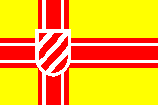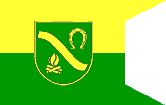- DOUBLE COTTICED (or COTISED)
- See Appendix VII.
- DOUBLE QUEUED
- The heraldic term used when a lion is showing a double tail a queue fourchι or
fourchιe (see also coward in appendix V and
queued).



Flag of Leichlingen, Germany (fotw): Flag of Muttenz, Switzerland (fotw); Flag of Sankt Vith, Belgium (fotw)
- DOUBLE-ARMED CROSS (or DOUBLE CROSS)
- See cross of Lorraine.
- DOUBLE-FIMBRIATED
- See cotticed 1) and following note (also
fimbriated).

Flag of Rudervereinigung Hellas-Titania, Germany (CS)
- DOUBLE-PAVON
- A term for the shape of the national flag of Nepal, which was apparently created by two
triangular pennants having been sewn together (see also pavon
and pennant 2)).


National Flag of Nepal (CS) Former Princely State of Dewas,
India (fotw)
Please note that this term has been introduced by the Editors
since no established alternative could be found.
- DOUBLE-POINTED
- A term for that variation of the swallow-tailed flag where a vertical section appears
in the centre of the fly (see also splittflag and
swallow-tail(ed)).

![[Iceland]](../images/v/vxt-d527a.gif)
![[Aaland Islands yacht ensign]](../images/v/vxt-d527b.gif)

from left: The Yacht Ensign of Denmark (fotw); Flag of Iceland (CS); Yacht Ensign of the Aaland Is, Finland (CS)
; Flag of Slupia, Poland (fotw)
- DOUBLE-PRINCE
- The term for a 17th Century Dutch naval flag usually (but not invariably) of six even, horizontal stripes
in the Dutch national colours repeated but see
triple-prince (also
princeflag and
tricolour 3))
![[double prince]](../images/v/vxt-d121.gif)

From left: Double Prince c1660 (CS); With Seven Stripes c1660 (fotw)
Please note however, whilst all available evidence
suggests that red, white and blue were employed, orange instead of red may
have been used at an earlier stage.
- DOUBLE-SIDED
- The term used when a flag is made from two separate pieces of cloth placed back to back,
either to ensure that the reverse of a flag is not a mirror image of the obverse (as in the
National Flag of Saudi Arabia) or (in the case of some military colours and others) is of a
different design (see also
two-sided 1),
obverse and
reverse).
![[absence example]](../images/v/vxt-d658.gif)
![[absence example]](../images/v/vxt-d658.gif)
The Obverse and Reverse of the National, double-sided Flag of Saudi Arabia (Graham Bartram)
- DOUBLE-SWALLOWTAIL
- See swallowtail and tongue.
- DOUBLE-TAILED DESCATE
- (adj) A term used to describe a fly that is cut into two tails with rounded
ends a cloven bullnose (see also fly,
gonfanon,
guidon 2),
multi-tailed descate,
standard 4),
swallowtail and
triple-tailed descate).
![[double tailed descate]](../images/v/vxt-d123.gif)
Double-Tailed Descate (CS)
- DOUBLE-TRESSURE
- The heraldic term for a usually decorated, double border inset from the edges of a shield,
banner of arms or flag, with one well-known example being the double-tressure decorated with
fleur-de-lis (fleuri-counterfleuri or flory-counterflory) on the royal banner of Scotland when
it may be known as a royal tressure (see also counter-,
fleur-de-lis and orle).


from left: Royal Banner of Scotland (fotw); Flag of Horebeke, Belgium (fotw)
Please note that the term tressure is considered by some heraldic writers to be a diminutive of orle but is rarely seen singly.
- DRACO
- A Roman military flag formed like a windsock whose open end was fixed to a dragons head with
gaping silver jaws (see also dragon flag
and windsock).
- DRACONARIUS
- A bearer of the draco.
- DRAGON FLAG
- 1) A pre-heraldic flag similar to the Roman Draco formed like a windsock, with
a dragons head/shape, and possibly having a whistling tube within it (see also
draco,
pre-heraldic,
'standard 6)' and
windsock).
- 2) The term for one of several varying designs of flag used in Imperial China
up to 1912 an imperial dragon flag.
![[imperial China dragon flag]](../images/v/vxt-d583.gif)
Chinese Imperial Flag c1890 (fotw)
Please note with regard to 1), it is suggested by
some authorities that the main standard used by the Saxons at the Battle of
Hastings (in 1066) was of this type.
- DRAPING
- (v) The decoration of a staff with a black cravat or long black ribbons (particularly
but not exclusively on flags that cannot be half-masted) as a sign of mourning but see
cravat 2)
(also cravat 1,
half-masted and
staff 2)).
- DRIEKLEUR
- The national flag of The Netherlands see tricolour 2) (also
princeflag).
- DRESS FLAG
- See indoor flag.
- DRESS KNOT
- A decorative knot of cord, possibly displaying the national colours or braided
in gold with blue thread, and attached to the sword a port epee or sword knot.
- DRESS SHIP, TO
- 1) (v) Generally, the practice of decorating a naval vessel for special occasions, such as
national days, whilst berthed alongside or at anchor, by stringing dressing lines
between the masts (and down to the ensign and jack staffs), and with national
flags at the mastheads - dressing ship, dressing overall or full dressing (see
also 'national flag',
'dressing lines'
'ensign staff',
'jack staff' and
'masthead').
- 2) (v) Specifically, in US naval usage, the practice of decorating a warship during lesser
commemorative occasions, whilst berthed alongside or at anchor, by displaying
the ensign and jack together with an ensign at each masthead, but without the
dressing lines but see 'dressing overall 2)' (see also
'dressing lines',
'masthead',
'naval ensign' under 'ensign' and
'naval jack' under 'jack').
- 3) (v) Specifically in British Royal Navy and some other naval usage, the practice of decorating
a warship with jack, ensign and masthead flags/ensign(s) but without the dressing lines, when
underway within sight of a port or anchorage during dress ship occasions but see
'dressing overall 3)'.
- 4) (v) The practice of merchant vessels (especially passenger liners) and
yachts to decorate themselves with strings of dressing lines on special occasions
such as maiden voyage departure and arrival, or on other occasions ordered by the
shipping company or club.
![[dressing ship example]](../images/v/vxt-d611.gif)
A Warship of the South African Navy Dressed Overall (Andries Burgers)
Please note that warships not directly involved
in the occasion being celebrated, but who are berthed in the presence or in sight
of ships that are, will also dress as a courtesy according to the local practice,
using the ensign or national flag of the celebrant at the main masthead in lieu
of their own ensign or national flag.
Please note also that this is a continuation of
the earlier maritime practice (dating from at least the 16th Century) of hanging
out every flag available by way of celebration, but that in modern navies and
some merchant marine companies both the occasions for display and the make-up
of dressing lines is strictly regulated (with this last being confined to signal
flags only).
- DRESSING LINES
- Signal flags and pennants made up in decorative strings according to the size
and configuration of ship they are to be used on and also according to ordered
patterns laid down by naval authorities in the case of warships, or commercial
companies in the case of merchant vessels rainbow lines (see also
dress ship, to 1),
dress ship, to 4) and
dressing overall).
- DRESSING (or DRESSED) OVERALL
- 1) See dress ship, to 1) and
dress ship, to 4).
- 2) (v or adj) In US naval usage the practice of decorating a vessel for major
commemorative occasions, whilst berthed alongside or at anchor, by stringing dressing
lines between the masts (and down to the ensign and jack staffs), and with a jack and
ensign at the bow and stern, and national flags at the mastheads but see
dress ship, to 2).
- 3) (v or adj) In British Royal Navy and some other usage decorating a vessel for
commemorative occasions, whilst berthed alongside or at anchor, by stringing dressing
lines between the masts (and down to the ensign and jack staffs), and with a jack and
ensign at the bow and stern, and national flags at the mastheads but see
dress ship, to 3).
- DRESSING SHIP
- SSee dress ship, to 1) and
dress ship, to 4).
- DRUM BANNER
- See bannerette and
war banner.






![[Iceland]](../images/v/vxt-d527a.gif)
![[Aaland Islands yacht ensign]](../images/v/vxt-d527b.gif)

![[double prince]](../images/v/vxt-d121.gif)

![[absence example]](../images/v/vxt-d658.gif)
![[absence example]](../images/v/vxt-d658.gif)


![[imperial China dragon flag]](../images/v/vxt-d583.gif)
![[dressing ship example]](../images/v/vxt-d611.gif)


![[double tailed descate]](../images/v/vxt-d123.gif)